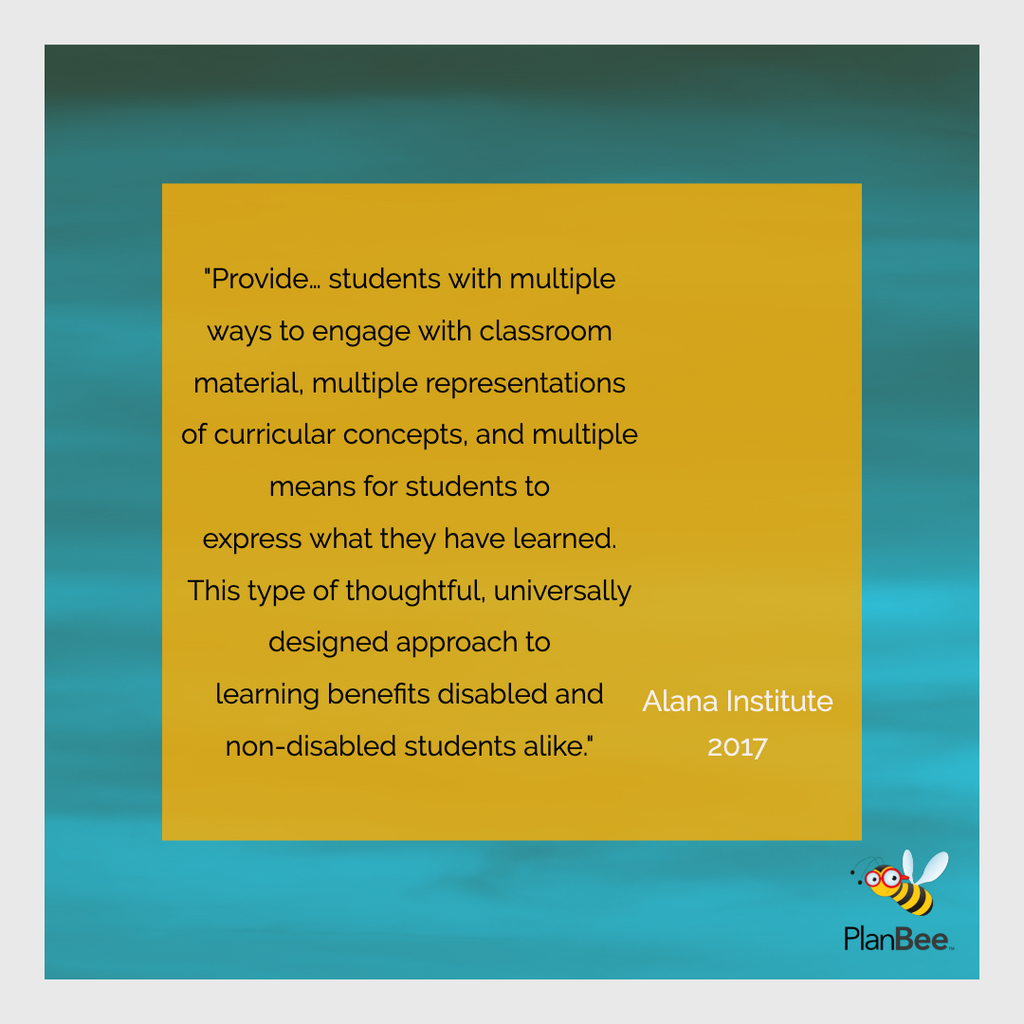Inclusion is a word that gets thrown around a lot in education, particularly in England and Wales, where the National Curriculum dictates that schools and teachers ensure all pupils are included in effective learning, regardless of their individual needs.
But what does inclusion actually mean, in the context of schools and education? What does inclusion look like in the classroom? And most importantly, how can teachers create an inclusive classroom that benefits all students, no matter what their individual needs?

What Inclusion Means
In the simplest terms, inclusion in education means ensuring every child, no matter what their individual needs or barriers to learning, has equal access to learning and the same opportunities to achieve.
Inclusion in schools is not just about providing additional support to children with special educational needs. It's about creating a learning environment that works for all pupils, whether they have a disability, speak English as an additional language, are a member of a minority community, come from a low-income family – or find it harder to learn and achieve for other reasons.
This creates a problem for teachers: how do you ensure inclusion for all of these children with their diverse needs and barriers to learning?
While it is usually necessary to put specific plans in place to meet the specific needs of children in your class, there are a number of things that all teachers can do to create a safe, happy, purposeful and inclusive environment. It is those broad, all-purpose examples of inclusion in the classroom which we've covered in this article.
Who Benefits From Inclusion
This comprehensive review of the impact of inclusive education found that the vast majority of learners without additional needs were either not impacted at all, or actually benefited, by the provision of inclusive classroom strategies. Effective inclusion benefits all students because they can take advantage of some of the additional support.

Why Inclusion Works
Supporting and celebrating diversity and inclusion in school works because it gives all children the potential to achieve, and creates an environment where those with additional needs are not segregated and seen as 'other'; they are part of the same community of learners. Inclusion addresses negative cultural attitudes and misconceptions about people with disabilities or those who are members of minority communities.

With that in mind, here are some of our recommended strategies that help create an inclusive classroom for all, regardless of specific needs:
Inclusive Classroom Strategies
- Define clear minimum standards for behaviour.
- Enforce those standards consistently.
- Deal with low level disruption in a sensitive way.
- Create opportunities to listen to all children.
- Develop a 'scaffolded' approach to learning.
- Be aware of the specific needs of every child in your class.
- Provide support for them in ways which benefit ALL children in your class.
- Create a calm, purposeful learning environment.
- Clearly display timetables and key information.
- Use pre-assessment to inform your planning.
- Let children choose how to show what they have learned.
- Don't compare the progress of one child to another; personal progress is key.
Let's take a closer look at what these twelve strategies look like in the classroom…
What Inclusion Looks Like
1 – Define clear minimum standards of behaviour.
Every child in your class should be absolutely clear about what the minimum, basic acceptable levels of behaviour are. These should be rules that are thought of and agreed by both you and your class. Once agreed, why not ask children to sign a class contract to make sure they understand that the class rules are everyone's responsibility to follow. You might even like to let children be involved in creating a class rules display.
Keep these short and simple, so everyone can understand them. Try to make these rules not about learning, specifically, but about ensuring everyone feels safe and respected.
Examples of rules you might agree on are:
- Be kind
- Keep your hands and feet to yourself
- Use kind words at all times
- Always respect the property of others
- Everyone has the right to feel safe and respected
- Everyone has the right to express themselves and be listened to
2 – Enforce those standards consistently.
Just as you must make the basic class rules absolutely clear and understood, you must also agree on consequences when those class rules are ignored.
These consequences must be proportionate and consistently applied. Remember: the rules for behaviour are the minimum of what is acceptable in your classroom, so try to be consistent with consequences when they are broken.
If you are aware of disruption in your class, the first port of call is to look at your own teaching. Ask yourself ‘is this lesson inclusive and engaging for all children?’ there may be a way of adapting your teaching to avoid such disruption.
Examples of an inclusive approach to behaviour management where a child is causing low-level disruption:
1st time: stop what you're doing and make eye contact. Position yourself or a supporting member of staff near the child.
2nd time: remind them to put their hand up and refer to the rules. Make sure the rest of the children are engaged in a quick task such as talk, pair, share, then approach the child away from other children and talk to them 1-1. You can be firm and say that the child is disrupting others' learning which is against the class rules and ask whether there is something you can do to help them engage in the lesson. Let them know if they choose to break the rules again, there will be a consequence - this would be linked to your agreed consequences.
3rd time: mark their name down on a piece of paper, but not on the board for all to see. Let the child know that they have continued to break the class rules which has resulted in the consequence discussed above.
Obviously, there will be occasions when children continue beyond the steps we've outlined here. Get into the habit of being curious about what is causing their behaviour. Thinking about the behaviour as connection-seeking rather than attention-seeking can help you to approach the situation in a calmer more positive way.
Download our free behaviour iceberg poster to help your school community look beneath the behaviours they see.
3 – Deal with low level disruption in a sensitive way.
You know how we said not to write the name of the child who kept calling out on the board? That's because it is an insensitive way of dealing with an issue, which visibly singles out a child in front of everyone. If you write a child's name down on a piece of paper, they know they have misbehaved. They also have the opportunity to stop, and amend their behaviour without further consequence.
If you write the name of a child who misbehaves on the board—visible to everyone—why would they choose to change their behaviour? Their name will remain up there, for all to see, regardless of whether they start to behave better, or not. It's humiliating – not inclusive, especially for children who regularly struggle with some of the basic rules (e.g. those with attention deficit disorders).
Read our blog about developing an authoritative teaching style for more tips on effective classroom management.
4 – Create opportunities to listen to all children.
This is especially important when resolving conflicts between children in your class. Allow time for the children involved to fully explain how they believe the incident arose, as well as what has upset them and why.
Create opportunities day-to-day, during normal lessons and learning, for children to be listened to as well. This helps them engage with the learning and feel included in it.
Listen to all children's thoughts in the creation of additional classroom rules (beyond the minimum, basic ones we talked about before).

5 – Develop a 'scaffolded' approach to learning.
What is 'scaffolding' in terms of teaching and learning? We could write an entire book about scaffolding, but in the simplest terms, scaffolding means giving support so that all pupils can access the same learning.
Scaffolding is absolutely key to creating an inclusive learning environment. You want all of the children in your class to be accessing the same information during a lesson (even if you slightly differentiate your resources and activities). Instead of activities that are entirely different to those you had planned for the rest of the class, why not plan activities with the same objectives and outcomes but scaffolding the activities to suit the children's needs.
The same goes for behaviour. For some children, following rules set out for the whole class can be tricky. For example, making a child with ADHD sit for a long period of time is near impossible, and therefore the expectation that all children sit on the carpet and listen for periods of time might not be an inclusive approach for that child. If you looked at the starting line of a race, where one child was in a wheelchair, that wouldn’t be a fair race. It is the same for those children with behavioural difficulties. To be inclusive is to adapt your approach to behaviour in the same way you would differentiate learning.
6 – Be aware of the specific needs of every child in your class.
For a truly inclusive classroom, it's not enough just to know which of your children have Special Educational Needs and Disabilities (SEND). You should know which, if any, of your children are on Free School Meals (FSM), which are caregivers, which are in foster care, which have English as an Additional Language (EAL) and which children are from the particularly vulnerable Roma or traveller communities.
Knowing this will help you consider every aspect of your classroom, and how you make it inclusive, safe and purposeful.
7 – Provide support for them in ways that benefit ALL children in your class.
Some inclusion strategies are so universally beneficial for all students, that they are worth doing in every classroom! For example, many children with dyslexic traits struggle to read pure black text on a pure white background. Simply changing the colours you use on your slides, avoiding black on white, can help not only children with a dyslexia diagnosis, but all children.
What if you have children with mild dyslexic traits that are unlikely to be diagnosed? Changing your slides will help them, too!
Changing the colours of your slides to ones that are less high-contrast makes them less tiring to view and read, too: better for everyone – you included!
This is just one example of an inclusive change that benefits all children, but there are many, many others.
8 – Create a calm, purposeful learning environment.
This is another big one which promotes inclusion for all in your classroom. We all need calm in order to learn. But creating a calm environment in class is a tricky thing to master.
Ensure you clearly define when group discussion or working is required and acceptable, and when it is not.
A calm environment is inclusive for many of your children, regardless of whether they have a special need for it or not.

If you would like to know more about creating calm classrooms read our 10 practical ways to create mentally healthy classrooms blog.
9 – Clearly display timetables and key information.
This is one of those little changes you can make which helps everyone, and makes all children feel included.
Some children with dyslexic and dyspraxic traits struggle with organisation, as do some with Autistic Spectrum Disorders (ASD). Clearly displaying timetables (visual timetables are great, especially for younger learners) helps them, and all your children, feel involved in the school day.
With a clearly displayed timetable, children can look ahead to their favourite or least favourite activities, and mentally prepare accordingly: they may think to themselves 'How will I show everyone how good I am at History later on?' or 'How will I cope with PE today?' Sharing the timetable for all to see includes children and empowers them.
The same is true for key vocabulary, facts or concepts relating to what you're currently learning in class. Stick this information up for all to see on display boards. This helps remind children of prior learning, and to answer questions or tackle tricky tasks.
10 – Use pre-assessment to inform your planning.
You might be thinking to yourself: 'What has this got to do with inclusion?' Well, again, this is about engaging children and making them feel like they have a say in their own learning.
Don't just assume what your children already know or don't know when you're planning a new topic; ask them! That way you'll identify areas which children are curious to learn more about, and avoid going over very familiar learning.
Pre-assessing children's prior knowledge, and interests around a subject, in this way shows them that they have been listened to, and included in their own learning. It's a powerful tool for inclusion in the classroom.
11 – Let children choose how to show what they have learned.
Inclusion works by finding the best way to ensure all children can access the learning, and have the opportunity to achieve. Setting exactly the same task for all children may not help you to achieve that, particularly when it comes to assessing learning.
When you get to the end of the topic, it might be tempting to assess children's learning with a written test. Don't do this (at least not every time, anyway)! Instead, offer children a choice of ways of presenting what they have learned. For example, at the end of a topic about the Arctic, give children the choice of showing their learning by:
- Writing a blog
- Creating a poster or infographic
- Making a slideshow presentation
- Recording a short information film or radio programme
Of course, you'll need to provide sufficient resources and support, plus encourage children to choose a way of showing their learning which plays to their own strengths.
Giving children a choice empowers them. It's inclusive, because it creates equal opportunities to show learning and progress in a way that a standard test (which many children struggle with) may not.
Download newspaper templates, KS1 diary templates, KS2 diary templates and cartoon templates for FREE to use in your classroom.

12 – Don't compare the progress of one child to another; personal progress is key.
And so, our final, and possibly most important strategy for an inclusive environment that benefits all students: don't compare them to one another!
Learning is not a competition. It is a never-ending process, a journey.
Think about yourself for a moment: If you had recently started learning electric guitar, would it feel fair if your guitar tutor compared you directly to Eric Clapton?
For some children with additional needs, the comparison between themselves and others in their class can feel as stark, and as disheartening. Don't do this. What's the point, anyway? How can comparing the attainment of one learner to another possibly help either of them?
Instead, focus entirely on children's personal progress, and encourage them to do the same. Ask: 'Can you do even better than you did last time?', 'What do you want to focus on that you found tricky the last time we looked at this?', or 'What's changed from when we started learning about this, to now?'.
Lastly: sometimes children just won't make progress with something. This can be crushing for any child, but particularly for those with special needs, who are more likely to have experienced disappointments like this – over and over again.
But you can make them feel included in the learning process, and capable of achieving, even if they haven't this time. How?
Even if a child hasn't made progress, they can identify ways in which they want to. Teach children that identifying their own shortcomings, or areas for improvement is learning. By doing so, they are still actively engaging with the learning and including themselves in it.
Why Inclusion is Important
Inclusion works because it gives children what we all want and need: a sense of belonging. Creating an inclusive classroom where everyone feels valued is incredibly powerful. You might not consider yourself to be the greatest teacher in the world, but you can be the greatest teacher in a child's life—the one they always remember, who had the greatest impact on them—by including them and making them feel safe and valued.
Wouldn't that be nice?
What does inclusion mean to you?
Phew! You've made it to the end of this massive list of inclusive classroom strategies. But that's just the tip of the iceberg. We know there are TONS of amazing ideas about diversity and inclusion in education which all you other teachers and educators have.
We bet you've got some ideas of your own, too. What does inclusion mean to you, and how will you change your classroom to be more inclusive?
If you liked this, have a read of some of our other blogs written for the teaching profession.
Don't forget to tell us in the comments below what inclusion means to you. You could also suggest a teaching topic you would like us to write a blog about.








20 Comments
To me , inclusion means welcoming every student as a child of God, valuing their unique gifts, and ensuring they feel loved, accepted, and able to learn alongside others. It reflects Christ’s call to love one another and build a community where everyone belongs.
Inclusion means that every student deserves to be educated in a way that meets their needs and encourages them to grow.
This is a very informative article. It highlighted the importance and effectiveness of inclusion. I am now comfortable creating my action plan, and I find it much easier to implement inclusion in my classroom. I believe that every child can learn and every child must learn.
Creating an inclusive classroom is essential for fostering diversity and ensuring every student feels valued. These practical tips offer effective strategies to promote equality, empathy, and a supportive learning environment.
To me, inclusion is the essence of education, in which the educator is intentional in creating a learning environment where the educational needs of all students are provided for, regardless of any barriers or obstacles to learning they may have. Even though I am not in the classroom but I will ensure that my teachers begin by identifying challenges to learning in each student then create the necessary interventions and accommodations.